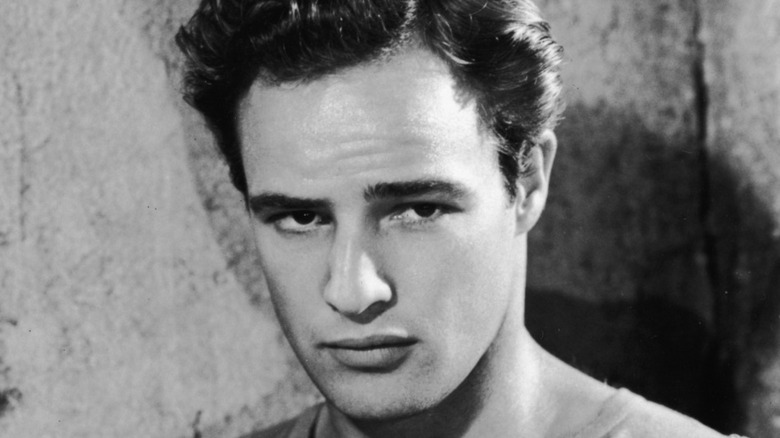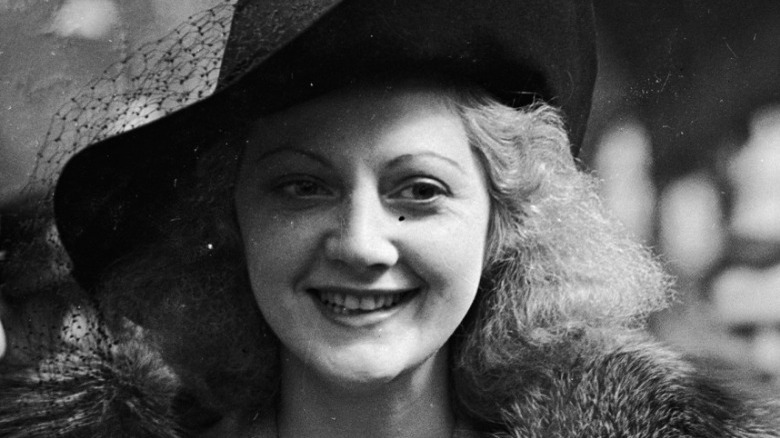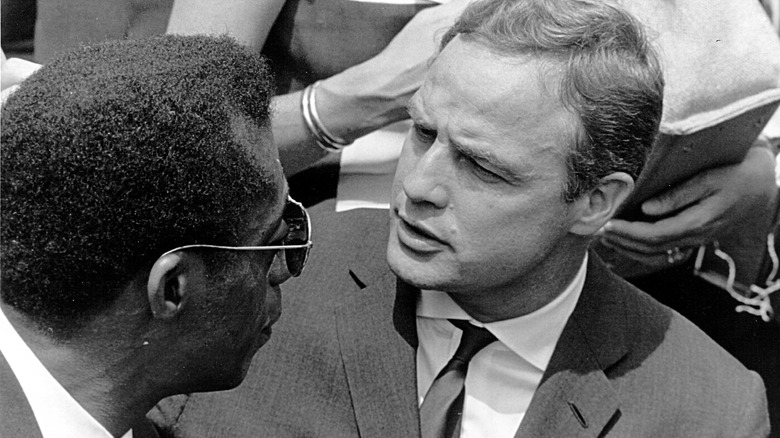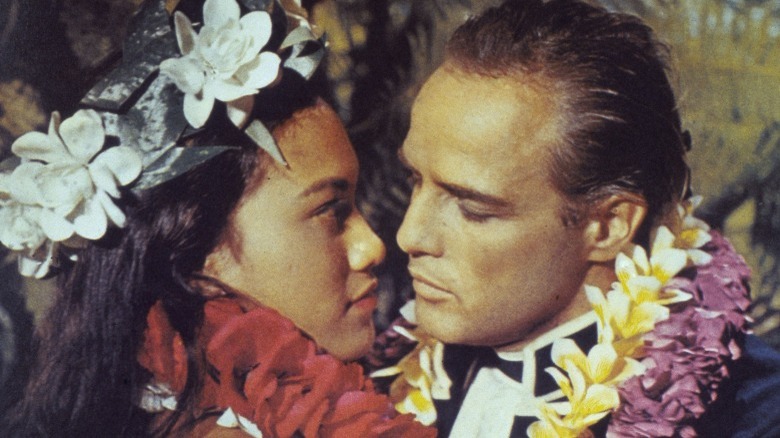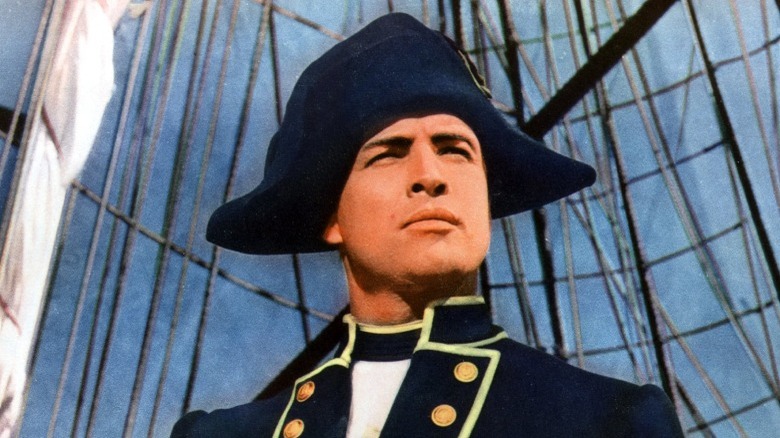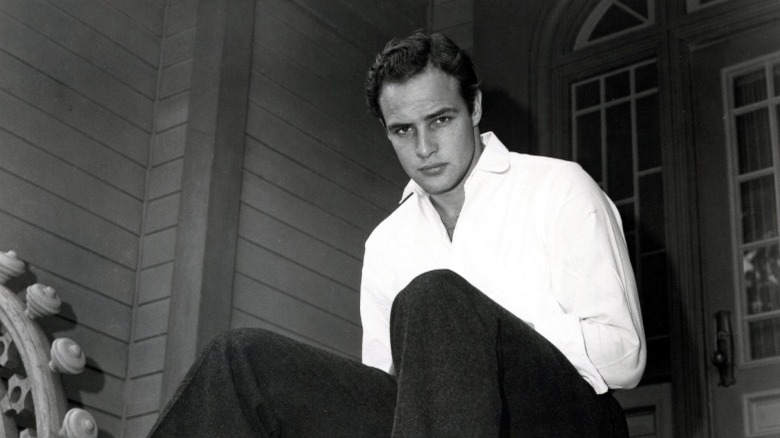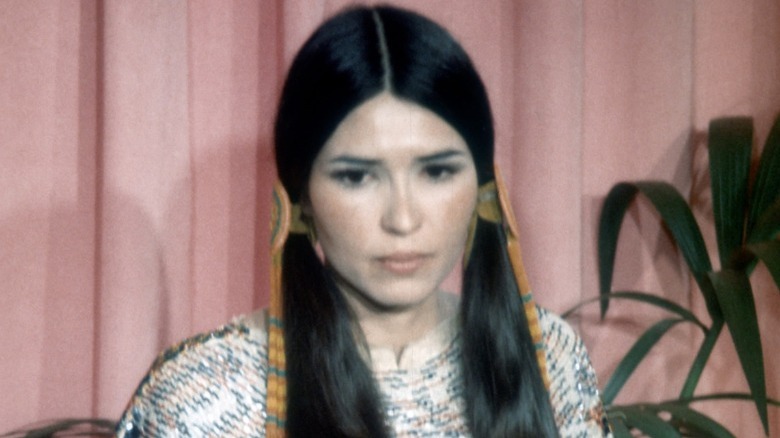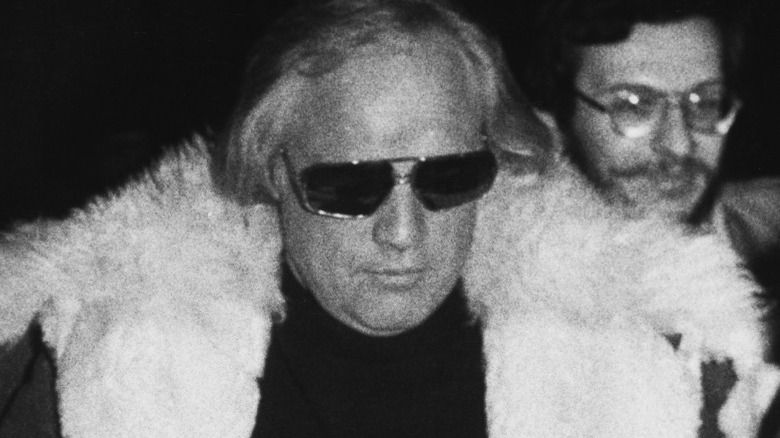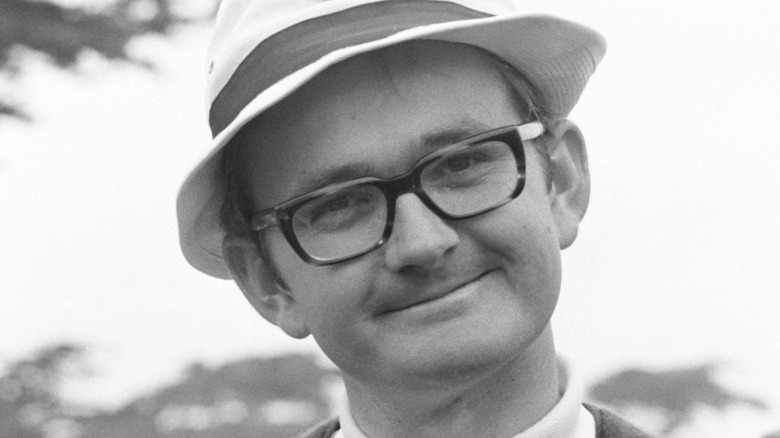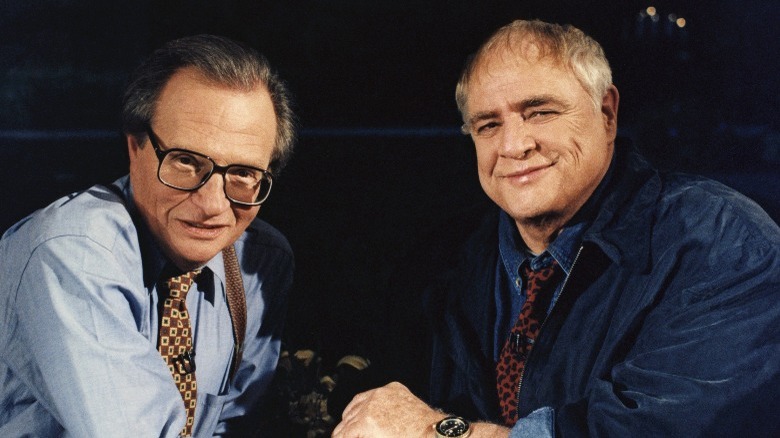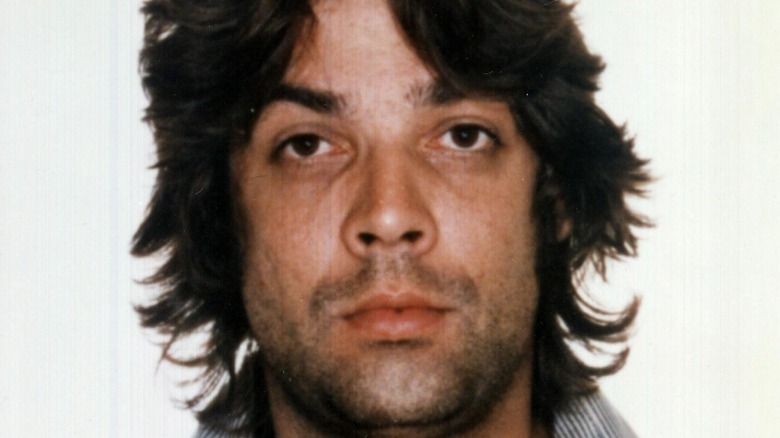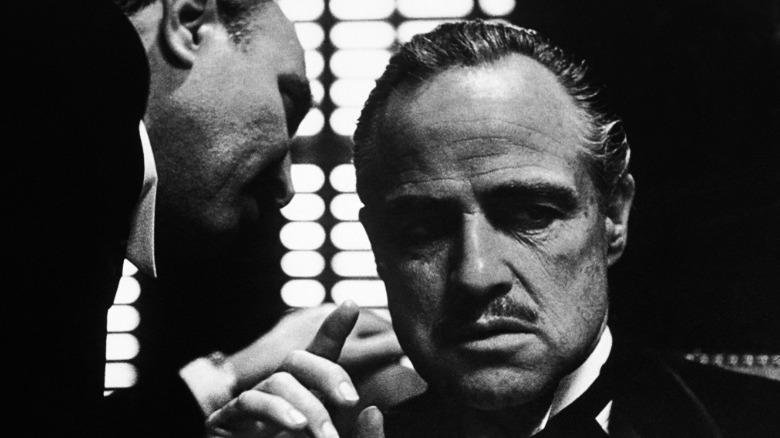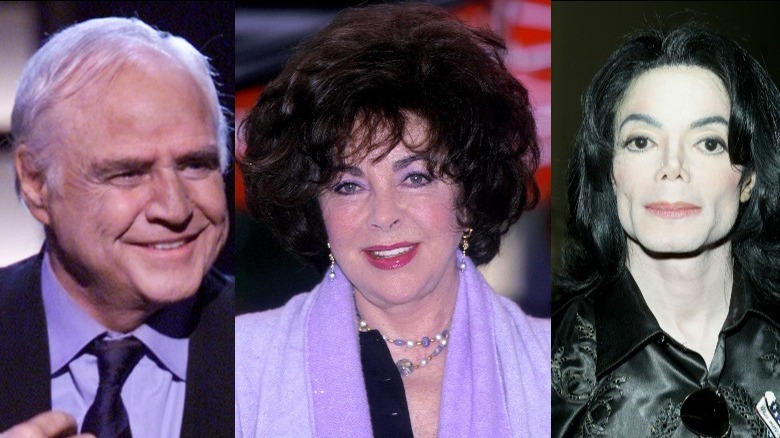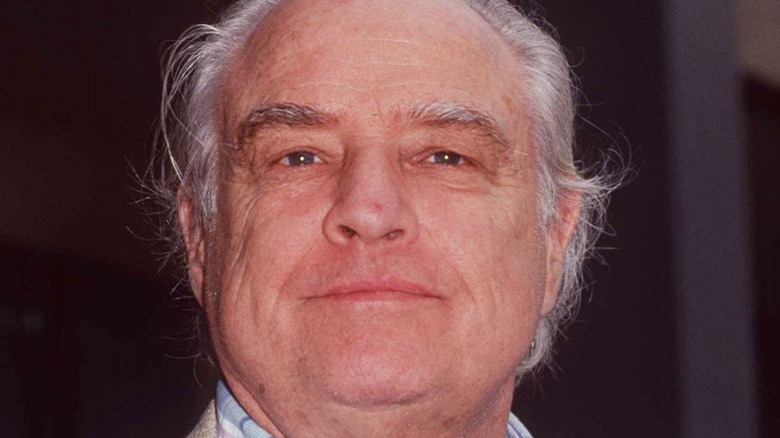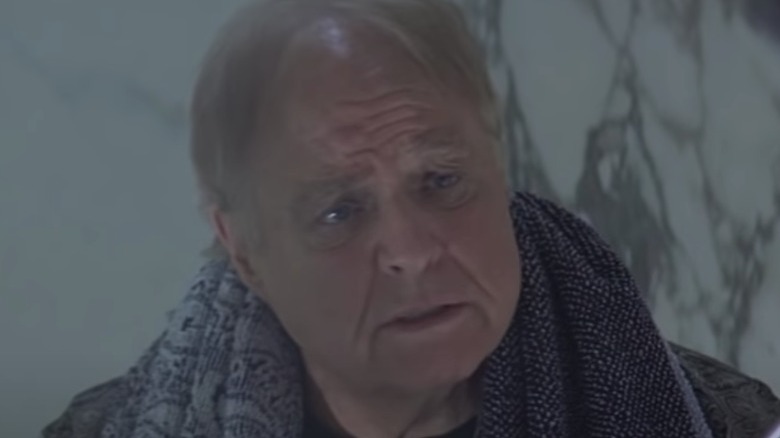The Untold Truth Of Marlon Brando
There is no doubt that Marlon Brando remains one of the towering artists and quintessential pop culture figures of the 20th century. An electrifyingly original actor for a good portion of his cinema and stage career, his personal life was notable for its myriad of eccentricities and family tragedies. From his youthful animal magnetism in such roles as Stanley Kowalski in the 1951 film adaptation of "A Streetcar Named Desire" to his iconic performance as Don Vito Corleone in "The Godfather," Brando's peerless genius as an actor will forever be an archetypal part of American culture.
Yet his peak cinematic achievements often contrasted with his aversion to the accompanying fame and adulation, and these conflicts often played out in rather bizarre ways. From smashing a predatory photographer's jaw to singing with and then planting a big fat smooch on interviewer Larry King, Brando could immolate the silver screen (reading his lines off cue cards, no less), advocate for social justice, and then retire to a furious bongo-playing session, all without missing a beat. So, allow us to make you an offer you can't refuse, as we invite you to take a closer look at the untold truth of Marlon Brando.
His close mentorship with acting teacher Stella Adler
Like many performers, Marlon Brando left his small town life to pursue his craft in New York City, a fated move that introduced him to one of the most influential people in his life: famed acting teacher Stella Adler. Brando moved from Illinois to New York City to live with his sister and enrolled at the New School, where Adler was teaching acting classes (via The Saturday Evening Post). Adler was a proponent of Method acting, a performance based on the observations of "textures, aesthetics, and sounds of everyday life, enabling [actors] to conjure detailed and realistic mental images on stage" (via Backstage). Brando was a self-admitted "very shy and sensitive child" (via HuffPost), so Adler championed the young Brando to help him hone his confidence and his acting talents. He became, according to screenwriter Bud Schulberg, "her greatest work of art" (via Vanity Fair).
Brando was so close with Adler that he virtually became a part of her family. According to Vanity Fair, Adler offered a de-facto home for the young Brando, and he soon developed a romance with her daughter, Ellen Adler. Ellen and Brando's lust eventually transformed into a deep friendship filled with hours-long phone calls until his passing in 2004. Brando revered Stella Adler and her teachings, so much so that according to HuffPost, he was Honorary Chairman of the Stella Adler Studio of Acting in New York City and even wrote the forward for her 1988 book, "The Technique of Acting." Of Adler, he said she was "not just a teacher of acting, but of life" (via The Los Angeles Times).
He was an outspoken social and political activist
Marlon Brando was an outspoken champion for a number of social and political movements. According to his "On The Waterfront" co-star Karl Malden, Brando was "always worried about the little guys on the bottom, all over the world" (via Vanity Fair). Post-World War II and before his film stardom, Brando traveled the country and stumped for the American League for a Free Palestine (via LitHub). In the 1960s, he became active in the civil rights movement: He raised money for Martin Luther King Jr. and attended the 1963 March on Washington for Jobs and Freedom (via The New Yorker). Eventually, Brando became an active ally of the Black Panthers, raising the organization's public profile and giving them financial support. Brando even delivered a eulogy at the funeral of teenager Bobby Hutton, a member of the Black Panthers, who was killed by Oakland police in 1968 (via The Guardian).
As the decades moved on, so did Brando's activism, who became a high-profile advocate for indigenous peoples. In 1973, Brando refused to accept his Academy Award for Best Actor in "The Godfather" by having activist Sacheen Littlefeather take the stage during the Oscars and give a speech denouncing Hollywood's depictions of Native American characters. He was also an early climate change activist, discussing the effects of CO2 on the environment in a 1994 interview with Larry King (via EW). Reflecting on his life, Brando's daughter Rebecca told GQ, "In the end he only made money so he could help fight injustices."
His numerous marriages and sexual liaisons
Marlon Brando's complicated love life was filled with marriages, liaisons, and dramas. He was married three times, and each relationship ended in divorce. Brando's first marriage in 1958 to actress Anna Kashfi lasted just over a year, with Kashfi claiming that Brando was physically and emotionally abusive and Brando saying he only married her because she was pregnant (via The Los Angeles Times). Brando's second marriage to actress Movita Castaneda began in secret and lasted for eight years, finally ending with an annulment in 1968 (via The Hollywood Reporter). His last marriage to Tarita Teriipaia, whom he met on the set of his film "Mutiny On The Bounty," was finished in 1972 (via Hollywood.com). But their relationship lasted for decades, and Teriipaia noted that Brando loomed over her life long after their marriage was done, even thwarting her attempts at new love (via Sydney Morning Herald).
In addition to his three marriages, Brando had some serious high-profile relationships. Actress Rita Moreno was with "bad guy" Brando for almost eight years, a relationship that left her so despondent that she tried to take her own life in his house (via Variety). He also had an on-again, off-again relationship with actress Jill Banner (via EW) and his lovers reportedly included actresses Marilyn Monroe, Shelly Winters, and Nancy Qwan (via New York Daily News). Brando was also reportedly involved with a number of men, including French actor Christian Marquand, and allegedly named his first child after him. In a 2018 interview with Vulture, music icon Quincy Jones claimed that Brando hooked up with Richard Pryor and Marvin Gaye. Jones quickly walked back his statements about Brando, but Richard Pryor's widow Jennifer confirmed the story to TMZ.
If you or anyone you know is having suicidal thoughts, please call the National Suicide Prevention Lifeline at 1-800-273-TALK (8255).
Mutiny On The Bounty was the movie that almost ruined his career
For Marlon Brando, "Mutiny On The Bounty" was supposed to be a cinematic blockbuster, and a triumph of his cinematic charisma and acting prowess. Instead, the film almost ruined his career. A remake of the 1935 film starring Clark Gable and Charles Laughton, "Mutiny On The Bounty" suffered from production delays, numerous script rewrites, and most notably at the time of the film's release in 1962, Brando's demanding behavior (via The New York Times). By the 1950s, he had already developed a reputation for being difficult and his role in "Mutiny" was meant to reinvigorate a career that was becoming increasingly marred by others' experience of Brando as "a petulant child," in the words of the film's director Lewis Milestone (via The Saturday Evening Post).
"Mutiny On The Bounty" not only failed to change his reputation of volatility, but it actually made things worse. Brando's attitude was so abhorrent during the making of "Mutiny On The Bounty" that Milestone told The Saturday Evening Post it should have been called "The Mutiny of Marlon Brando," while producer Aaron Rosenberg called working with Brando "six weeks of hell." According to The New York Times, upon its release, "Mutiny On The Bounty" was a bomb at the box office, and its failure marked the beginning of Brando's career decent in the 1960s.
His contentious relationship with fame
Brando — the first Hollywood actor to be paid $1 million for an acting role (for "Mutiny on the Bounty") — had plenty of star power, but also harbored seething contempt for the spotlight. In fact, you could say he absolutely loathed being famous, and he despised praise for his own talents in particular. His friend Ellen Adler, daughter of famed acting teacher Stella Adler, told Vanity Fair of Brando's feelings on fame, "He spent his whole life trying to run away from it. But of course he couldn't. He was on his way to being the most famous actor in the world, and the more famous he got, the more he hated it." She also said there were unspoken rules among his friends to not celebrate his work or talk about his fame. "On the Waterfront" screenwriter Budd Schuberg said that Brando seemingly resented anyone who dared praise his Oscar-winning performance in the film.
Brando found refuge from the burdens of fame on his own island estate. While filming 1962's "Mutiny on The Bounty," Brando was introduced to the South Pacific island of Tetiaroa, located 35 miles north of Tahiti. He bought the island in 1966 and remained its legal owner until his death in 2004 (via The Los Angeles Times). Friend and co-executor of his estate Mike Medavoy said that for Brando, Tetiaroa was his "paradise," and "It was a place for him to get away from everything. This was especially important to a person who had a whole thing about the difference between being a celebrity and being a human being" (via The Hollywood Reporter).
Why he refused his Oscar for The Godfather
In one of the most memorable Academy Award moments of all-time, Marlon Brando refused his Oscar for Best Actor in "The Godfather" as a form of protest and a moment of advocacy. When Brando's name was announced as a winner, Indigenous activist Sacheen Littlefeather took the stage in his place. Although Brando had written a speech denouncing Hollywood stereotypes of Native populations, there wasn't enough time to read it in the 60 second slot Littlefeather was given to be on stage, so she improvised one instead (via The Guardian).
At the time of the 45th Academy Awards in 1973, a month-long standoff between Native American activists and U.S. authorities had been taking place at Wounded Knee, South Dakota. The FBI had ordered a news blackout of the Wounded Knee occupation, and Brando saw the Oscars telecast as a way to work around authorities and give activists a platform for their message (via The Los Angeles Times). Brando's plan worked, and 85 million people around the world heard Littlefeather's words. The speech was met with a mix of applause and boos, with actor John Wayne so upset that, according to Littlefeather, he wanted to charge the stage and had to be restrained by six security guards. However, after the speech, Littlefeather says that she received praise from leaders of Native American movement, as well as activists like Cesar Chavez and Coretta Scott King (the widow of Dr. Martin Luther King). In the end, as she notes to The Guardian, Littlefeather remains proud of making the Oscars the site of important activism, and of being able to do so "like a warrior woman," who "spoke from [her] heart."
The time he broke a photographer's jaw
Brando struggled with his fame ever since "A Streetcar Named Desire" launched him into superstardom, and his contentious relationship with it came to a boil in 1973 with a violent confrontation with a paparazzo. Photographer Ron Galella was known for his obsession with taking pictures of celebrities. Called a "creep, a stalker and worse" (via The New York Times), Galella made a name for himself with his unrelenting pursuit of photographing the rich and famous, notoriously dogging Jacqueline Kennedy Onassis until a court ordered him to stop.
Brando and Galella came to blows on June 12, 1973 when — after following Brando all day — Galella asked him to take off his sunglasses for a photo. According to The New York Times, when Brando said no and Galella persisted, Brando punched Galella, breaking his jaw and knocking out five of his teeth. Galella said he received a five-figure settlement from Brando over the incident, but his busted face did not stop him from further pursuit of the perfect Brando shot. In an interview with Vanity Fair, Galella notes that he simply started wearing a football helmet around the actor for protection. He also speculates that Brando punched him in retaliation for Galella's obsession with Jackie Kennedy, as Brando reportedly had an affair with Kennedy in 1965.
His decades-long friendship with comedian Wally Cox
Marlon Brando — an actor known for the butch aesthetics of characters like sweaty, t-shirt-clad Stanley Kowalski in "A Streetcar Named Desire" and rebelliously leathered-up Johnny in "The Wild One" — was best friends with a cartoon dog decked out in a baggy shirt tucked into his tights. Technically, Brando wasn't besties with Underdog, but he was lifelong friends with the voice actor of that character: comedian Wally Cox. He and Cox had a friendship dating back to their childhood in Evanston, Illinois, where they met as 9-year-old boys. They both eventually moved to New York City, where Brando found success on stage and screen and Cox became the star of the television show "Mr. Peepers." Brando and Cox bonded over laughter and their shared "mischievous sense of humor" (via The Los Angeles Times).
Their close bond was not without its troubles. Brando was a jealous friend, with several of Cox's wives telling The Los Angeles Times that Brando treated them coldly, as if they were intruders on his friendship. There are long-standing rumors that Brando and Cox were not just friends, but lovers as well. However, that has never been confirmed. What can be confirmed is their bond was close, so much so that after Cox's death in 1973, Brando carried his ashes with him for years, ignoring the wishes of Cox's widow to scatter them in hills that Cox loved. According to The Los Angeles Times, when Brando passed away in 2004, his ashes, together with Cox's, were spread in Death Valley, California.
Brando's infamous interviews
Even in the early days of his career, Brando was known for being press-averse. By the mid-1950s, Brando was the biggest movie star of the time, and yet he was puzzlingly elusive; so much so that he had to be bribed by producers to do press for films and he even hired private investigators to follow Time Inc. to try to combat the press' attention to his personal life (via CJR). In 1957, The New Yorker magazine sent up-and-coming journalist Truman Capote to Japan to profile the making of Brando's latest film "Sayonara." Armed with a bottle of vodka, an impeccable auditory memory, and the ability to ask all the right questions, Capote sat Brando down for a six-hour conversation. This interview would become the basis for his article "The Duke In His Domain," a story so influential that it "marked a clear evolution of celebrity journalism and heralded the arrival of the invasive, full-immersion pop culture of today" (via CJR). Brando hated the piece so much that he permanently blacklisted Capote from his life and he rarely gave interviews again.
However, Brando would once again give a memorable interview in 1994 on "Larry King Live." In the only interview to publicize his autobiography "Songs My Mother Taught Me," Brando dressed to match Larry King's red suspenders, exuding equal parts lucidity and absurdity, and capped it all off with a smooch for King. Their chat was so notorious that "Saturday Night Live" lampooned it, with Kevin Nealon as King and John Travolta as Brando.
The tragic lives of his children
There is no definitive account of Marlon Brando, the father. At the time of Marlon Brando's death in 2004, The New York Times noted in his obituary that he was the father of 11 known children: five from his marriage, three with his housekeeper, and three from other affairs, with other possible children in the paternity mix. Brando was notoriously private about his children, refusing to write about them in his 1994 autobiography "Songs My Mother Taught Me" (via The New York Times). By the time of the book's publication, several of Brando's children had gone through a series of tragic events.
Christian Brando, Marlon's eldest and "number one son" (via The Guardian), dealt with excessive alcohol and drug use and familial instability that played out in a bitter, decades-long custody battle between Brando and his first wife, actress Anna Kashfi. In 1990, Christian shot and killed Dag Drollet, the boyfriend of his half-sister Cheyenne, after Cheyenne told him that she was being abused by Drollet. Cheyenne later admitted that Drollet had not harmed her and Christian pleaded guilty to voluntary manslaughter and served four and a half years in a California state prison. In 1994, after reportedly experiencing depression after Drollet's death, Cheyenne died by suicide at the age of 24 (via The Los Angeles Times). During Christian's trial, Marlon Brando testified on his behalf, saying "I tried to be a good father," adding, "I did the best I could" (via The New York Times).
If you or anyone you know is having suicidal thoughts, please call the National Suicide Prevention Lifeline at 1-800-273-TALK (8255).
Brando almost didn't play Don Vito Corleone in The Godfather
It's hard to imagine any actor other than Marlon Brando portraying Don Vito Corleone in the film "The Godfather," but he was far from the first choice to play the fabled mafia don. By the time "The Godfather" was in development at Paramount Studios in the early 1970s, Brando's career was in the doldrums created by his own misbehavior. When "Godfather" author Mario Puzo and young filmmaker Francis Ford Coppola suggested Brando play the patriarch of the Corleone family, studio executives balked at his choice. Charlie Bludhorn, head of Paramount's parent company Gulf and Western, declared Brando "box office poison" and Paramount studio head Robert Evans said "Marlon was as dead as can be" (via Vanity Fair). Even Brando had his doubts about the role, initially rejecting the part because, as Vanity Fair notes, he didn't want to glorify the Mafia.
But there's nothing like a bit of jealousy to fuel one's ambition. According to Vanity Fair, when Brando learned that Paramount was eyeing acting legend Laurence Olivier to play Don Corleone, he had a change of heart. However, it soon became Brando's role to lose, because in order to secure the part, Brando had to agree to Paramount president Stanley Jaffe's terms, which included putting up a $1 million bond (as insurance for his notorious moodiness and tardiness), taking a pay cut, and submitting a screen test. Brando agreed, and with a dash of makeup and some tissues stuffed into his cheeks, he transformed himself into one of cinema's most iconic characters.
His alleged road trip with Elizabeth Taylor and Michael Jackson has become celebrity folklore
Marlon Brando, Elizabeth Taylor, and Michael Jackson all get into a car and take a cross-country road trip, stopping at every KFC and Burger King along the way, so Brando can indulge in his favorite fast food treats. Sounds like a strange piece of fan fiction lurking in the back corners of the Internet, but this is an allegedly true story that has quickly become Hollywood folklore. The story was first published in the 2011 Vanity Fair article "Elizabeth Taylor's Closing Act" and details Brando, Taylor, and Jackson's attempts to leave New York City in the aftermath of the September 11th attacks.
With no flights available, the trio — at the behest of Jackson — went to New Jersey and then hit the road, allegedly driving as far as Ohio. Sources close to Taylor deny that she partook in the trip, saying she stayed in New York City and consoled those affected by the attack. However, other sources say Taylor remained in New York so that her friend and fellow Hollywood legend Debbie Reynolds wouldn't be alone (via People). Whatever the truth is, clearly Taylor's people didn't want her involved in the story.
The thought of Brando, Taylor, and Jackson trucking along an midwestern highway so engrossed pop culture imaginations that the story was adapted into a segment for the British television series "Urban Myths" starring Brian Cox as Brando, Stockard Channing as Taylor, and Joseph Fiennes as Jackson. Protest and criticism over the casting of a white actor as Michael Jackson ultimately caused the episode to be pulled from the air (via Billboard).
He had his own secret acting school
Towards the end of his life, a cash-strapped Marlon Brando got into the teaching business with a 10-day acting seminar that had A-list celebrity students and a grade-A reputation for being one of Hollywood's more bizarre happenings. According to The Hollywood Reporter, in 2001, Brando — faced with ill health and financial woes — was looking for a quick payday by selling his ideas on QVC. At the suggestion of his long-time assistant Alice Marchak, he decided to produce a series of instructional acting DVDs starring himself. Renting a Hollywood warehouse, hiring a video crew, and inviting his famous friends to partake in his sessions, it was slyly called "Lying For A Living."
The production of "Lying For A Living" was plagued with troubles, including fights between Brando and Tony Kaye, the project's initial director, and the increasingly wacky behavior of its star. Even many of his celebrity students started to leave the sessions, with actors Sean Penn, Edward James Olmos, and Robin Williams reportedly the only notable pupils to stick out the entire 10-day class. Filled to the brim with Brando's eccentric behavior — such as having the students strip naked, bringing in a homeless man for a lesson, and mooning the students — "Lying For A Living" was never released to the public. While Brando's antics may sound ridiculous, Olmos tells The Hollywood Reporter that the acting legend was "as serious as a heart attack" about teaching this class, which was "going to be his legacy to the acting community." Hundreds of hours of footage of this seminar exist, but Brando's estate plans to keep it private, with Brando's estate executor Mike Medavoy saying that "they're under lock and key" and wishing the whole thing would be forgotten.
His last movie roles were never released
Marlon Brando is widely considered one of the greatest cinematic performers of all time, so it's a bit surprising that his last roles were never even released. It might be for the best, however, because Brando's career could have ended with a cameo in the "Scary Movie" franchise and a small voice role in the unreleased animated feature film "Big Bug Man." While the horror genre-spoofing "Scary Movie" films have been a hit with audiences, grossing almost $500 million dollars at the box office, critics have been less impressed by the franchise's "crudity and grossness" (via Rotten Tomatoes). The legendary Brando was set to appear in the opening of "Scary Movie 2" in a spoof of "The Exorcist," opposite Natasha Lyonne and Andy Richter, where he would play a priest performing an exorcism. He dropped out due to health reasons, but not before filming scenes with Lyonne. On why Brando would want to appear in a gross-out bawdy comedy, Lyonne told Entertainment Weekly, "I don't know what he was thinking."
Brando's "Scary Movie 2" cameo remains locked away, and so does his official last film role in "Big Bug Man." The animated film about a man who gets special powers through insect bites has never been released. Brando voiced elderly Mrs. Sour, described by the film's executive producer Gabriel Grunfeld as "a funny, acerbic old lady — a sort of mean Willie Wonka" (via The Guardian). Brando recorded his role just weeks before his death in 2004, dressing the part in an old woman's drag, and reportedly saying it was "the most fun I've had since playing Julius Caesar" (via The Guardian).
